Labor Union Report: Historical Events, Strategies and Legal Analysis
VerifiedAdded on 2022/08/12
|7
|1187
|11
Report
AI Summary
This report provides an overview of the American labor union movement, beginning with its inception in 1881. It discusses the legal framework, including the role of the National Labor Relations Board (NLRB), and the impact of legislation on union activities. The report highlights key historical events such as the Homestead and Pullman strikes, which significantly shaped the labor movement. It analyzes the strategies employed in forming unions, emphasizing the importance of organizers, understanding labor laws, and involving workers in decision-making. Furthermore, the report examines the AFL-CIO's role in improving workers' lives and rights, including its efforts to promote diversity and address economic challenges. In conclusion, the report underscores the historical struggle of the labor class, effective union formation strategies, and the impact of significant events on the labor movement in the United States.
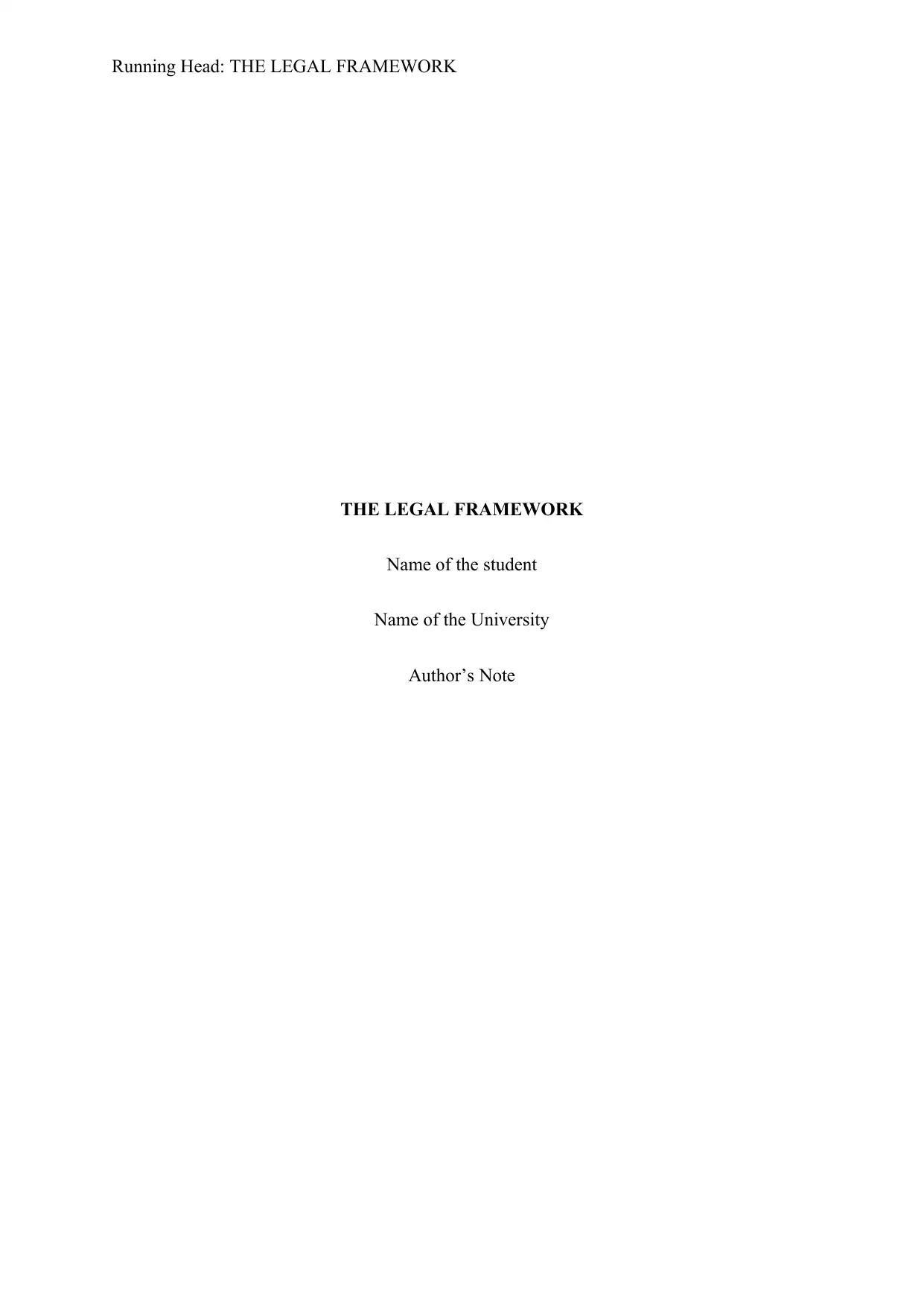
Running Head: THE LEGAL FRAMEWORK
THE LEGAL FRAMEWORK
Name of the student
Name of the University
Author’s Note
THE LEGAL FRAMEWORK
Name of the student
Name of the University
Author’s Note
Paraphrase This Document
Need a fresh take? Get an instant paraphrase of this document with our AI Paraphraser
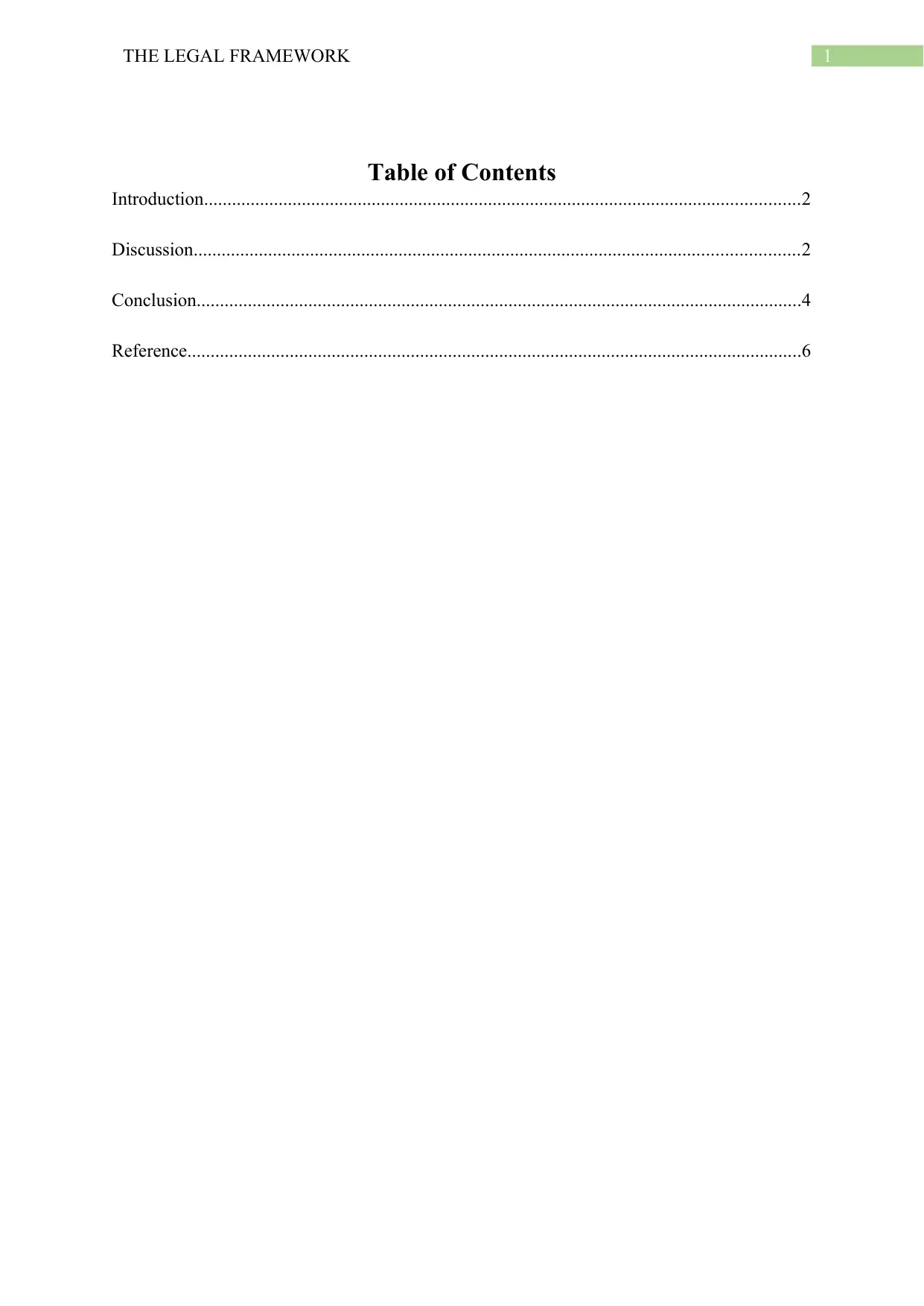
1THE LEGAL FRAMEWORK
Table of Contents
Introduction................................................................................................................................2
Discussion..................................................................................................................................2
Conclusion..................................................................................................................................4
Reference....................................................................................................................................6
Table of Contents
Introduction................................................................................................................................2
Discussion..................................................................................................................................2
Conclusion..................................................................................................................................4
Reference....................................................................................................................................6
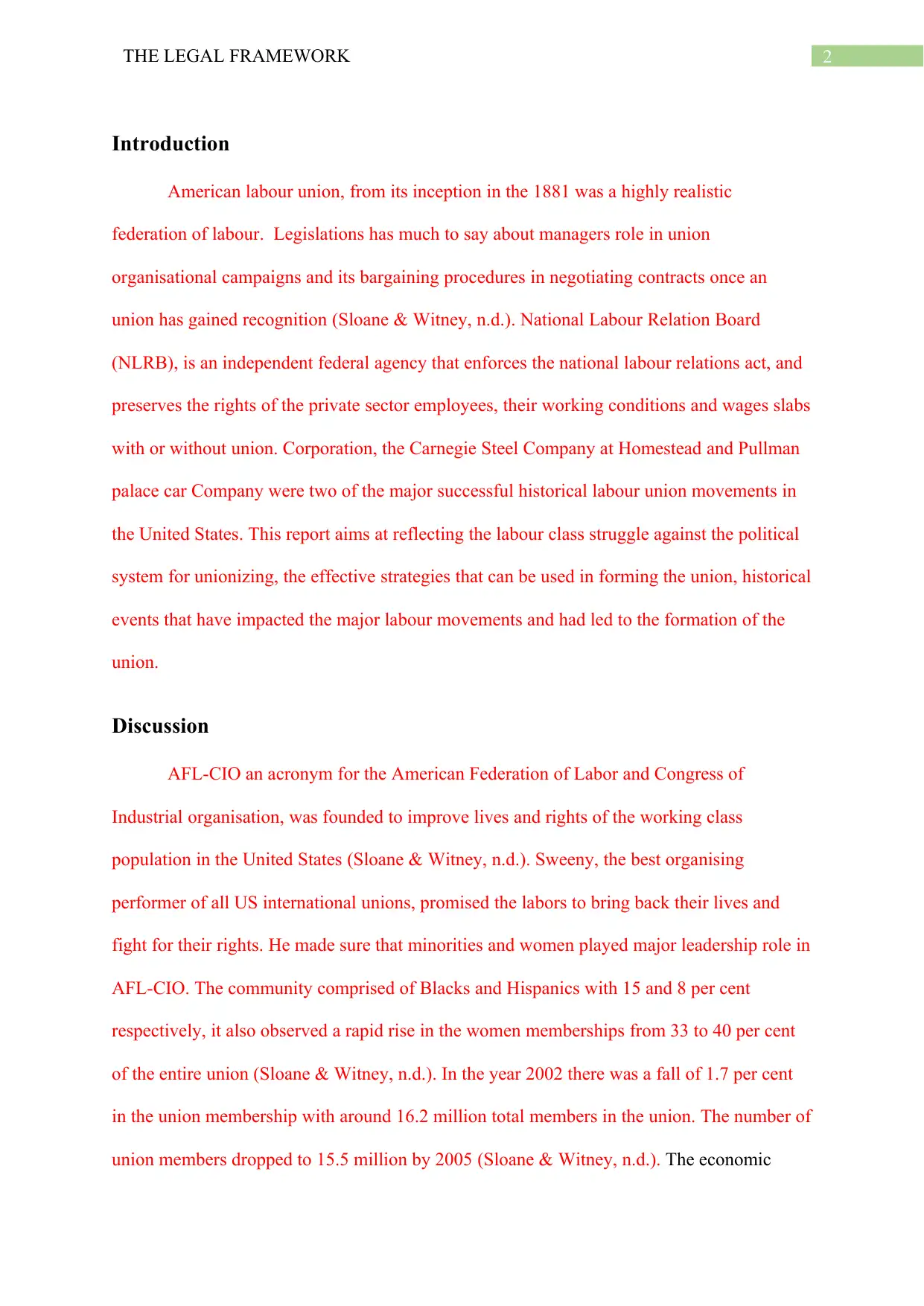
2THE LEGAL FRAMEWORK
Introduction
American labour union, from its inception in the 1881 was a highly realistic
federation of labour. Legislations has much to say about managers role in union
organisational campaigns and its bargaining procedures in negotiating contracts once an
union has gained recognition (Sloane & Witney, n.d.). National Labour Relation Board
(NLRB), is an independent federal agency that enforces the national labour relations act, and
preserves the rights of the private sector employees, their working conditions and wages slabs
with or without union. Corporation, the Carnegie Steel Company at Homestead and Pullman
palace car Company were two of the major successful historical labour union movements in
the United States. This report aims at reflecting the labour class struggle against the political
system for unionizing, the effective strategies that can be used in forming the union, historical
events that have impacted the major labour movements and had led to the formation of the
union.
Discussion
AFL-CIO an acronym for the American Federation of Labor and Congress of
Industrial organisation, was founded to improve lives and rights of the working class
population in the United States (Sloane & Witney, n.d.). Sweeny, the best organising
performer of all US international unions, promised the labors to bring back their lives and
fight for their rights. He made sure that minorities and women played major leadership role in
AFL-CIO. The community comprised of Blacks and Hispanics with 15 and 8 per cent
respectively, it also observed a rapid rise in the women memberships from 33 to 40 per cent
of the entire union (Sloane & Witney, n.d.). In the year 2002 there was a fall of 1.7 per cent
in the union membership with around 16.2 million total members in the union. The number of
union members dropped to 15.5 million by 2005 (Sloane & Witney, n.d.). The economic
Introduction
American labour union, from its inception in the 1881 was a highly realistic
federation of labour. Legislations has much to say about managers role in union
organisational campaigns and its bargaining procedures in negotiating contracts once an
union has gained recognition (Sloane & Witney, n.d.). National Labour Relation Board
(NLRB), is an independent federal agency that enforces the national labour relations act, and
preserves the rights of the private sector employees, their working conditions and wages slabs
with or without union. Corporation, the Carnegie Steel Company at Homestead and Pullman
palace car Company were two of the major successful historical labour union movements in
the United States. This report aims at reflecting the labour class struggle against the political
system for unionizing, the effective strategies that can be used in forming the union, historical
events that have impacted the major labour movements and had led to the formation of the
union.
Discussion
AFL-CIO an acronym for the American Federation of Labor and Congress of
Industrial organisation, was founded to improve lives and rights of the working class
population in the United States (Sloane & Witney, n.d.). Sweeny, the best organising
performer of all US international unions, promised the labors to bring back their lives and
fight for their rights. He made sure that minorities and women played major leadership role in
AFL-CIO. The community comprised of Blacks and Hispanics with 15 and 8 per cent
respectively, it also observed a rapid rise in the women memberships from 33 to 40 per cent
of the entire union (Sloane & Witney, n.d.). In the year 2002 there was a fall of 1.7 per cent
in the union membership with around 16.2 million total members in the union. The number of
union members dropped to 15.5 million by 2005 (Sloane & Witney, n.d.). The economic
⊘ This is a preview!⊘
Do you want full access?
Subscribe today to unlock all pages.

Trusted by 1+ million students worldwide
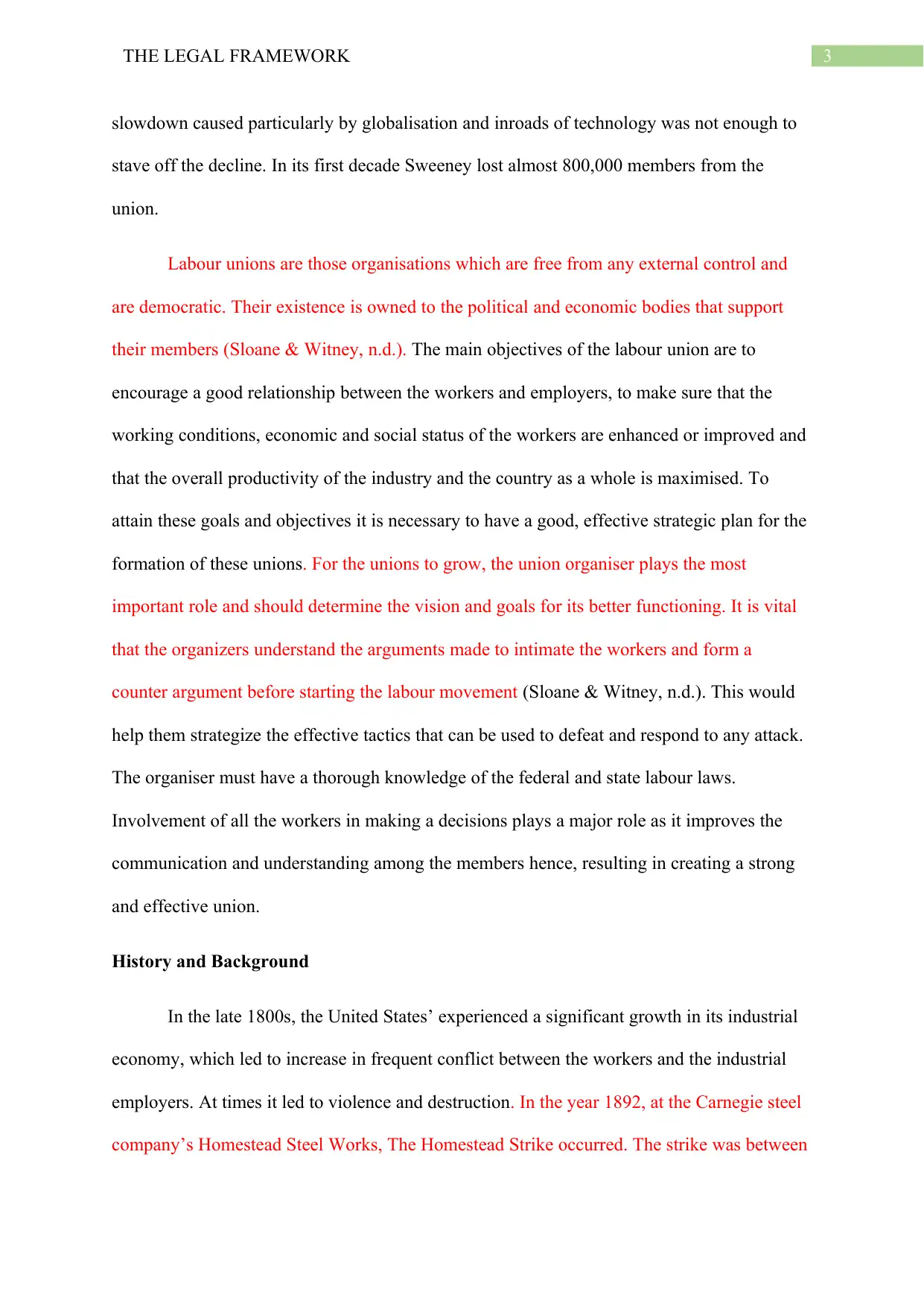
3THE LEGAL FRAMEWORK
slowdown caused particularly by globalisation and inroads of technology was not enough to
stave off the decline. In its first decade Sweeney lost almost 800,000 members from the
union.
Labour unions are those organisations which are free from any external control and
are democratic. Their existence is owned to the political and economic bodies that support
their members (Sloane & Witney, n.d.). The main objectives of the labour union are to
encourage a good relationship between the workers and employers, to make sure that the
working conditions, economic and social status of the workers are enhanced or improved and
that the overall productivity of the industry and the country as a whole is maximised. To
attain these goals and objectives it is necessary to have a good, effective strategic plan for the
formation of these unions. For the unions to grow, the union organiser plays the most
important role and should determine the vision and goals for its better functioning. It is vital
that the organizers understand the arguments made to intimate the workers and form a
counter argument before starting the labour movement (Sloane & Witney, n.d.). This would
help them strategize the effective tactics that can be used to defeat and respond to any attack.
The organiser must have a thorough knowledge of the federal and state labour laws.
Involvement of all the workers in making a decisions plays a major role as it improves the
communication and understanding among the members hence, resulting in creating a strong
and effective union.
History and Background
In the late 1800s, the United States’ experienced a significant growth in its industrial
economy, which led to increase in frequent conflict between the workers and the industrial
employers. At times it led to violence and destruction. In the year 1892, at the Carnegie steel
company’s Homestead Steel Works, The Homestead Strike occurred. The strike was between
slowdown caused particularly by globalisation and inroads of technology was not enough to
stave off the decline. In its first decade Sweeney lost almost 800,000 members from the
union.
Labour unions are those organisations which are free from any external control and
are democratic. Their existence is owned to the political and economic bodies that support
their members (Sloane & Witney, n.d.). The main objectives of the labour union are to
encourage a good relationship between the workers and employers, to make sure that the
working conditions, economic and social status of the workers are enhanced or improved and
that the overall productivity of the industry and the country as a whole is maximised. To
attain these goals and objectives it is necessary to have a good, effective strategic plan for the
formation of these unions. For the unions to grow, the union organiser plays the most
important role and should determine the vision and goals for its better functioning. It is vital
that the organizers understand the arguments made to intimate the workers and form a
counter argument before starting the labour movement (Sloane & Witney, n.d.). This would
help them strategize the effective tactics that can be used to defeat and respond to any attack.
The organiser must have a thorough knowledge of the federal and state labour laws.
Involvement of all the workers in making a decisions plays a major role as it improves the
communication and understanding among the members hence, resulting in creating a strong
and effective union.
History and Background
In the late 1800s, the United States’ experienced a significant growth in its industrial
economy, which led to increase in frequent conflict between the workers and the industrial
employers. At times it led to violence and destruction. In the year 1892, at the Carnegie steel
company’s Homestead Steel Works, The Homestead Strike occurred. The strike was between
Paraphrase This Document
Need a fresh take? Get an instant paraphrase of this document with our AI Paraphraser
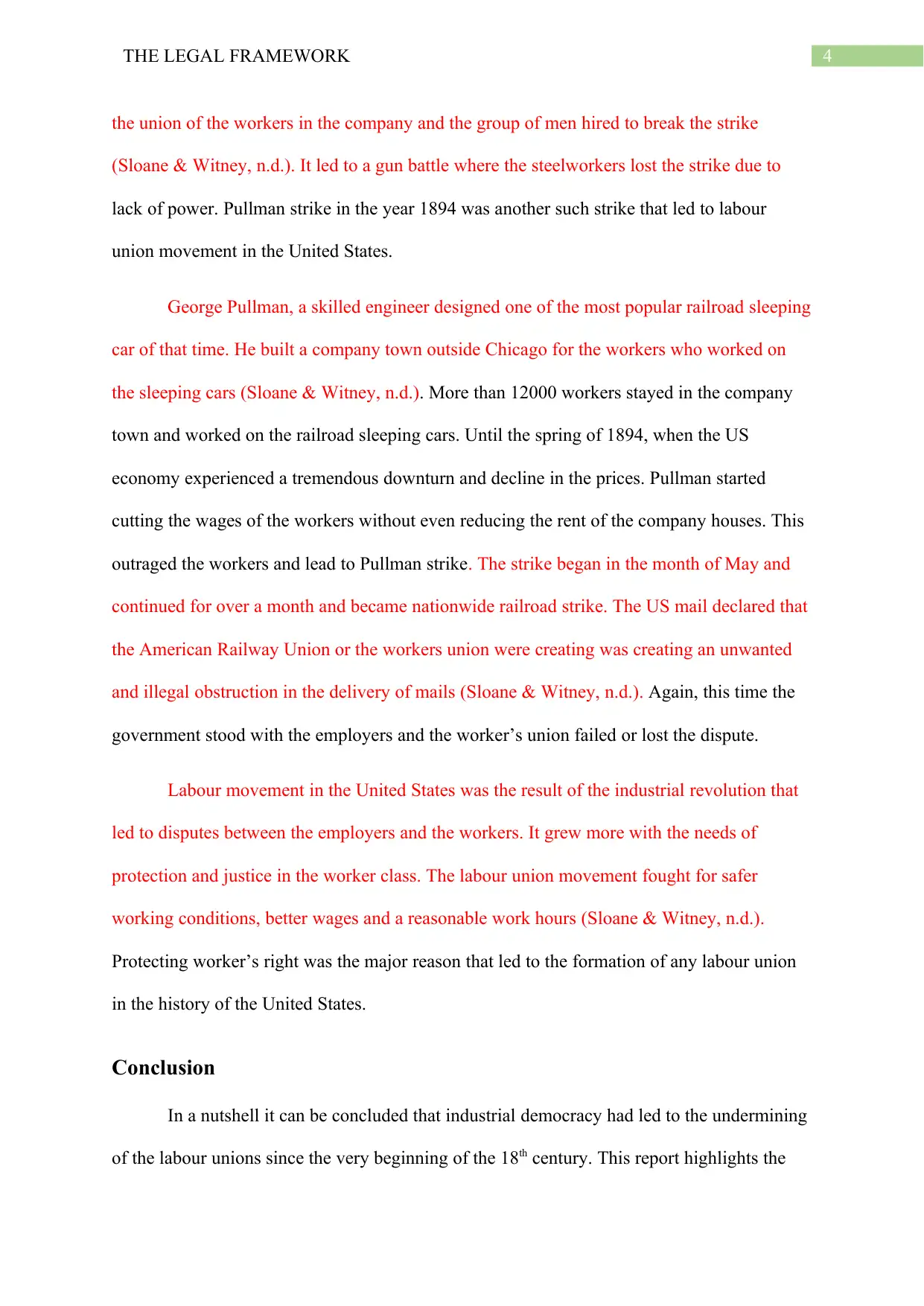
4THE LEGAL FRAMEWORK
the union of the workers in the company and the group of men hired to break the strike
(Sloane & Witney, n.d.). It led to a gun battle where the steelworkers lost the strike due to
lack of power. Pullman strike in the year 1894 was another such strike that led to labour
union movement in the United States.
George Pullman, a skilled engineer designed one of the most popular railroad sleeping
car of that time. He built a company town outside Chicago for the workers who worked on
the sleeping cars (Sloane & Witney, n.d.). More than 12000 workers stayed in the company
town and worked on the railroad sleeping cars. Until the spring of 1894, when the US
economy experienced a tremendous downturn and decline in the prices. Pullman started
cutting the wages of the workers without even reducing the rent of the company houses. This
outraged the workers and lead to Pullman strike. The strike began in the month of May and
continued for over a month and became nationwide railroad strike. The US mail declared that
the American Railway Union or the workers union were creating was creating an unwanted
and illegal obstruction in the delivery of mails (Sloane & Witney, n.d.). Again, this time the
government stood with the employers and the worker’s union failed or lost the dispute.
Labour movement in the United States was the result of the industrial revolution that
led to disputes between the employers and the workers. It grew more with the needs of
protection and justice in the worker class. The labour union movement fought for safer
working conditions, better wages and a reasonable work hours (Sloane & Witney, n.d.).
Protecting worker’s right was the major reason that led to the formation of any labour union
in the history of the United States.
Conclusion
In a nutshell it can be concluded that industrial democracy had led to the undermining
of the labour unions since the very beginning of the 18th century. This report highlights the
the union of the workers in the company and the group of men hired to break the strike
(Sloane & Witney, n.d.). It led to a gun battle where the steelworkers lost the strike due to
lack of power. Pullman strike in the year 1894 was another such strike that led to labour
union movement in the United States.
George Pullman, a skilled engineer designed one of the most popular railroad sleeping
car of that time. He built a company town outside Chicago for the workers who worked on
the sleeping cars (Sloane & Witney, n.d.). More than 12000 workers stayed in the company
town and worked on the railroad sleeping cars. Until the spring of 1894, when the US
economy experienced a tremendous downturn and decline in the prices. Pullman started
cutting the wages of the workers without even reducing the rent of the company houses. This
outraged the workers and lead to Pullman strike. The strike began in the month of May and
continued for over a month and became nationwide railroad strike. The US mail declared that
the American Railway Union or the workers union were creating was creating an unwanted
and illegal obstruction in the delivery of mails (Sloane & Witney, n.d.). Again, this time the
government stood with the employers and the worker’s union failed or lost the dispute.
Labour movement in the United States was the result of the industrial revolution that
led to disputes between the employers and the workers. It grew more with the needs of
protection and justice in the worker class. The labour union movement fought for safer
working conditions, better wages and a reasonable work hours (Sloane & Witney, n.d.).
Protecting worker’s right was the major reason that led to the formation of any labour union
in the history of the United States.
Conclusion
In a nutshell it can be concluded that industrial democracy had led to the undermining
of the labour unions since the very beginning of the 18th century. This report highlights the
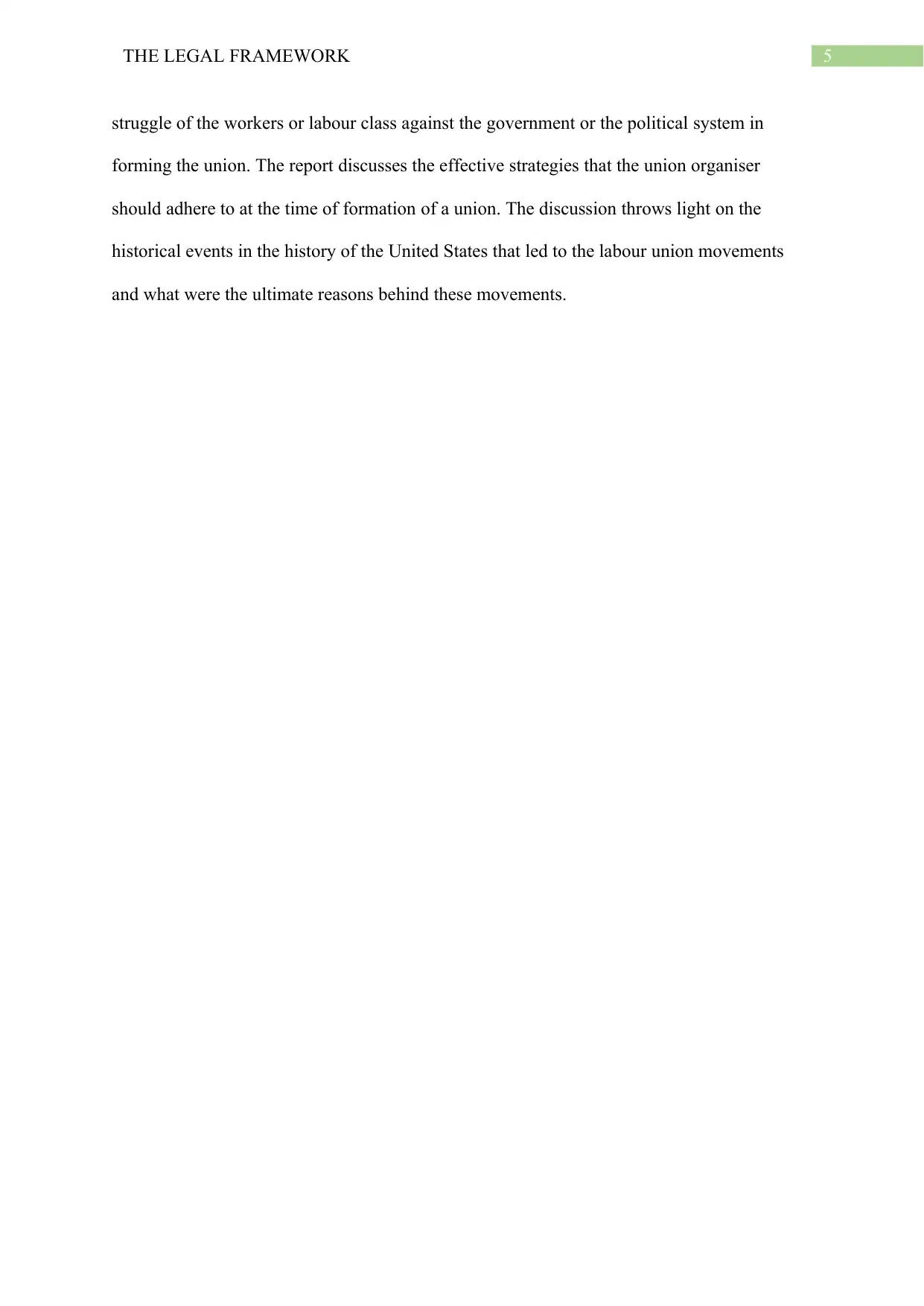
5THE LEGAL FRAMEWORK
struggle of the workers or labour class against the government or the political system in
forming the union. The report discusses the effective strategies that the union organiser
should adhere to at the time of formation of a union. The discussion throws light on the
historical events in the history of the United States that led to the labour union movements
and what were the ultimate reasons behind these movements.
struggle of the workers or labour class against the government or the political system in
forming the union. The report discusses the effective strategies that the union organiser
should adhere to at the time of formation of a union. The discussion throws light on the
historical events in the history of the United States that led to the labour union movements
and what were the ultimate reasons behind these movements.
⊘ This is a preview!⊘
Do you want full access?
Subscribe today to unlock all pages.

Trusted by 1+ million students worldwide
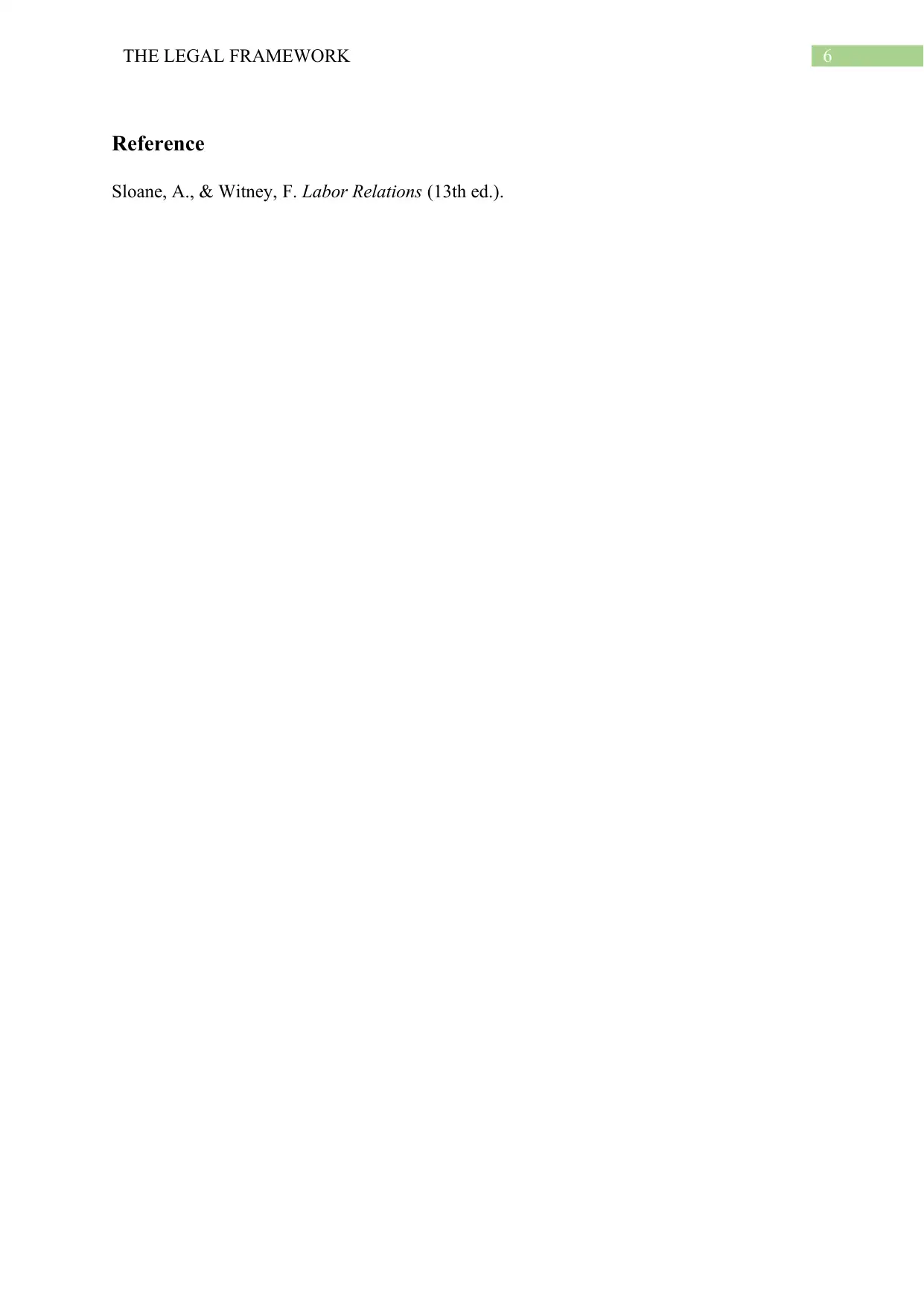
6THE LEGAL FRAMEWORK
Reference
Sloane, A., & Witney, F. Labor Relations (13th ed.).
Reference
Sloane, A., & Witney, F. Labor Relations (13th ed.).
1 out of 7
Your All-in-One AI-Powered Toolkit for Academic Success.
+13062052269
info@desklib.com
Available 24*7 on WhatsApp / Email
![[object Object]](/_next/static/media/star-bottom.7253800d.svg)
Unlock your academic potential
Copyright © 2020–2025 A2Z Services. All Rights Reserved. Developed and managed by ZUCOL.
